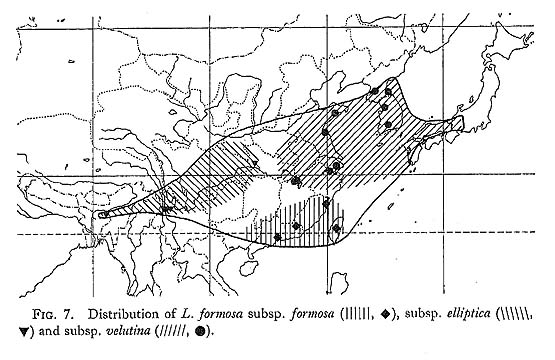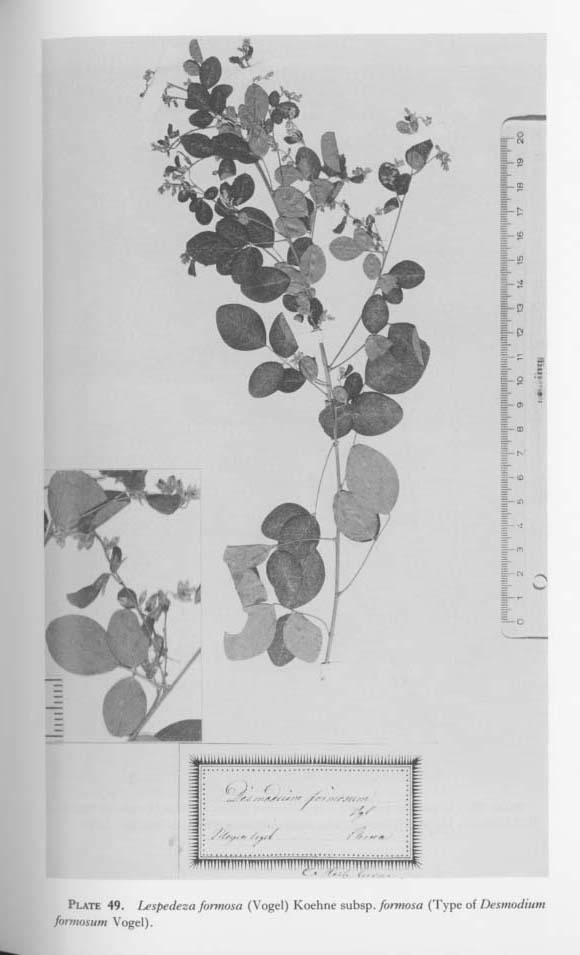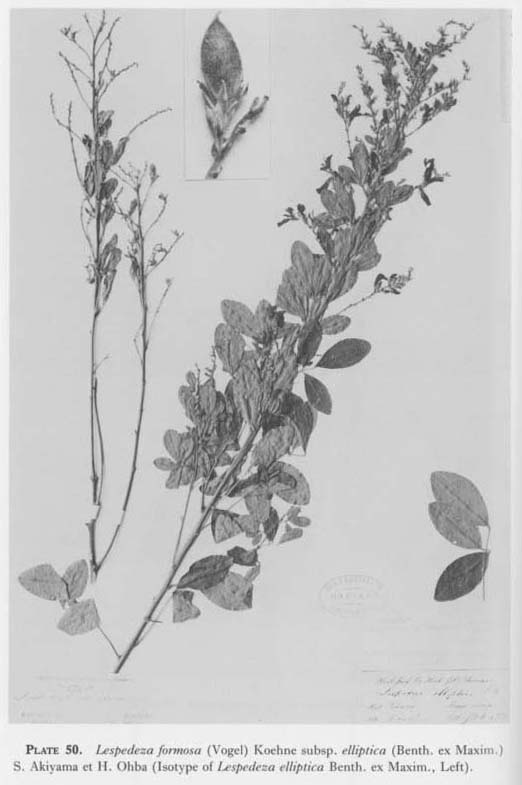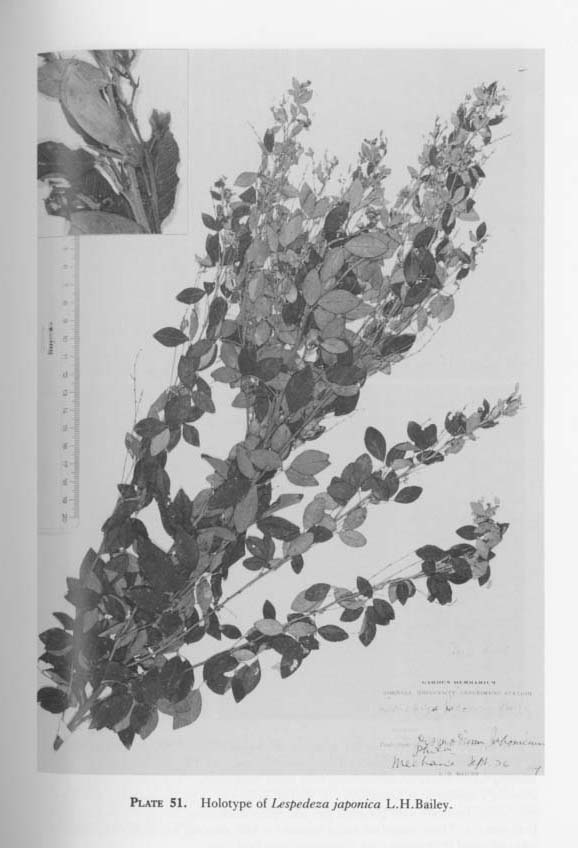TAXONOMY OF LESPEDEZA FORMOSA (VOGEL) KOEHNE
Shinobu AKIYAMA and Hideaki OHBA
|
Lespedeza formosa (Vogel) Koehne is a widely distributed and very variable species occurring in Japan, Korea, China, Taiwan and Assam. From these areas many taxa which are attributed to this species were described such as L. viatorum Champ. ex Benth., L. elliptica Benth. ex Maxim., L.japonica L. H. Bailey (from cultivated stock), L. kiusiana Nakai, L. pubescens Hayata, L. nipponica Nakai, L. satsumensis Nakai, etc. (see taxonomic treatment, p. 225). Although L. formosa has been treated by several taxonomists (Schindler, 1913; Fu, 1955; Hatusima, 1967; Murata, 1978; Hsu et al., 1983), the comparison among plants through its entire distribution area has not yet been undertaken. Thus the taxonomic status is still obscure. Working with a revision of the species of the section Macrolespedeza of the genus Lespedeza we found it desirable to clear the geographical variation of L. formosa in the entire range. On the other hand, the range of L. formosa agrees with the common pattern of the species designated as the "group I" of Japono-Himalayan element (Kanai, 1963) or "M-I group" of Japono-Himalayan related plants (Kanai, 1966). Hence, in order to reveal the floristic relationship between Himalaya and Japan the comparative study of L. formosa is also significant. We wish to express our gratitude to the late Professor Hiroshi Hara, for his kind suggestions and encouragement. Much thanks are due to the members of the Botanical Expedition to Himalaya in 1983 and 1985 for their help and advice. We are also grateful to the curators of the herbaria cited in Material and Method for their kindness in permitting us to study specimens and to borrow valuable collections. Historical SurveyL. formosa was first described by Vogel (1843) under the genus Desmodium based on a specimen from Macao, Bentham described L. viatorum. based on the Champion's collection from "Little Hong-Kong" (Champion, 1852). He cited Parkes's Chinese collection, and Vachell's collection from Macao and the adjacent islands under the species. But he did not refer to D.formosum, On the other hand L, elliptica was described based on the Griffith's collection from east Bengal (Maximowicz, 1876). Though Maximowicz regarded both L. viatorum and L. elliptica as distinct species in sect. Macrolespedeza, he was unaware that D.formosum was a species belonging to Lespedeza. In 1893 Koehne made a new combination, L. formosa, but he considered it a Japanese species and cited L. racemosa. and L. Sieboldii as synonyms. Schindler (1913) proposed the widest concept of L. formosa in. which he included L. viatorum, L. elliptica, and even L. racemosa and L. Sieboldii which are conspecific with L. Thunbereii (DC.) Nakai. Fu (1955) adopted L. formosa in the sense of Schindler and recognized three local forms in regard to the Chinese plants: "L. elliptica" Form in Yunnan, "L. formosa (s.s.)" Form, which is recognized as conspecific with L. viatorum, from Kwangtung to Kiangsi, Chekiang, Fukien and Taiwan, and the third Form in Chin Ling, Hupeh and Szechuan. Recently Hsu et al (1983) studied topoclinal variation of L. bicolor Turcz. in China proper, and concluded that L. formosa and L. elliptica are subspecies of L. bicolor. This is not acceptable, because L. bicolor and L. formosa have numerous essen-tial differences in the shape of various floral and vegetative features (Akiyama, in press). Regarding Japanese plants Hatusima (1967) recognized both L. japonica L. H. Bailey and L. kiusiana from Japan and Korea as conspecific with L. formosa. Hatusima described a local variety of L. formosa, var. australis, from the southernmost part of Kyushu. While, Murata (1978) distinguished L. japonica (including L. kiusiana) from L. formosa sensu stricto. But Murata and also Hatusima omitted L. elliptica from the synonymy of L. formosa, but did not mention the relationship of these two. Akiyama and Ohba (1983) considered L. formosa var. australis to be conspecific with L. satsumen-sis Nakai and tentatively treated L. satsumensis, L. kiusiana, L. japonica and L. formosa as distinct species. Material and MethodThis study was mainly based on the herbarium specimens and partly on living material. We made a field survey in Hong Kong and Kowloon in 1985 and we used living material cultivated at Botanical Gardens, Koishikawa, University of Tokyo. Leaflets were examined by a scanning electron microscope (Hitachi S-700, University Museum, University of Tokyo). Herbarium specimens of the following herbaria were used: A: Arnold Arboretum of Harvard University,BH: L.H. Bailey Hortorium, Mann Library Building, Cornell University, Ithaca, New York, CAL: Central National Herbarium, Botanical Survey of India, GH: Gray Herbarium of Harvard University, HK: Herbarium, Agricultural and Fisheries Department, Hong Kong, KAG: Herbarium, Faculty of Agriculture, Kagoshima University, KANA: Herbarium, Faculty of Science, Kanazawa University, KIEL: Botanischcs Institut der Universität Kiel, KYO: Herbarium, Department of Botany, Faculty of Science, Kyoto University, L: Rijksherbarium, Leiden, LE: Herba-rium of Department of Higher Plants, V. L. Komarov Botanical Institute of the Academy of Science of U.S.S.R., Leningrad, NA: Herbarium, U.S. National Arbo-retum, Washington D. C., TI: Herbarium, Department of Botany, University Muse-um, University of Tokyo, TNS: Herbarium, National Science Museum, Tokyo. Result and DiscussionVariation of flowers: In "L. kiusina"* from Japan, the standard of the flower has a distinct claw, narrowly lunate to lunate auricles, and the shape of lamina is obovate to elliptic (Fig. 1a). The standards have also distinct claws and lunate auricles and the shape of lamina is similar to that of "L. kiusiana", in the specimens collected from Korea (Fig. 1b & c), various localities in China (Fig. 1d-m) and Assam (Fig. 1n & o). But the standards from Hong Kong and Kwangtung (Fig. 1f-i) have a tendency to be longer; those from Szechuan, Yunnan and Assam (Fig. 1j-o) have a tendency to become larger. The shape of the wings in the specimens from Korea, China and Assam is narrowly obovate (Fig. 2b-o) and also similar to that of "L. kiusiana" (Fig. 2a). The shape of keel-petals in these specimens is also indistinguishable from that of "L. kiusiana" (Fig. 3). In these specimens the shape of calyx-lobes varies from triangular to narrowly triangular. In flowers, no essential significant differences are found among the specimens collected in various localities from Japan to Assam through Korea and China. However, the shape and size of calyx-lobe and also the relative length of calyx/corolla of L.formosa sensu lato has a tendency to geographical variation (Figs. 4 & 5).
In Hong Kong, Kwangtung, Fukien and Taiwan, the length of flower varies from 10 mm to 15 mm, the length of calyx is 3.0 mm to 4.6 mm, and the calyx-lobe is triangular and nearly equal to or shorter than the calyx-tube (Fig. 4f-i). Their corolla is three to four times longer than the calyx (Figs. 5f-i & 6 (
In Assam, Yunnan, Szechuan and Hupeh, the length of flower is 13.1 mm to 14.9 mm and longer than that of Japan and Korea. Their calyx-lobe is narrowly triangular (Fig. 4j-o); the calyx-lobe is one and half times to three times longer than the calyx-tube; the relative length of calyx-lobe/calyx-tube is longer than that of Hong Kong, Kwangtung, Fukien and Taiwan, and also that of Japan and Korea (Figs. 5j-o & 6 ( In Shantung, Kiangsi and Kiangsu, the length of flower is nearly equal to that of Japan and Korea. Their calyx-lobe is narrowly triangular and slightly longer to one and half times longer than the calyx-tube; the corolla is two to three times longer than the calyx (Figs. 4d & e, 5d & e and 6 ( Variation of hairiness: The presence and persistency of appressed dense hairs on the upper surface of leaves is one of the characteristics of Japanese and Korean plants (Hatusima, 1967; Murata, 1978). It is remarkable that some individuals from E China also have leaves with pubescent upper surface (Plate 48a), while others from E China are nearly glabrous (Plate 48b). Those from Assam, Yunnan, Szechuan and Hupeh are also pubescent on the upper surface (Plate 48c & d). Those from Hong Kong, Kwang-tung, Fukien and Taiwan are variable in their hairiness; that is, some are densely pubes-cent not only in flowering but even in fruiting (Plate 48g), or nearly glabrous from the first (Plate 48h & i), while others have both densely (Plate 48e) and sparsely pubescent leaves (Plate 48f) within a single plant. In a few specimens examined many scars are observed on the upper surface of leaves (Plate 48d & f). In these cases some hairs fall down as the case of "L. satsumensis" (Akiyama & Ohba 1983). The type specimen of L. formosa has sparsely pubescent leaves on upper surface. It seems that the leaves are densely pubescent at first and then a lot of hairs are lost.
Fu (1955) considered L. formosa to be glabrous on upper surface of leaves. Murata (1978) pointed that the leaves of "L. formosa" are pubescent on the upper surface in flowering and become glabrescent in fruiting but those of "L. japonica" are pubescent till fruiting. From our observation of L. formosa sensu lato, some specimens from Hong Kong, Kwangtung and Taiwan are apparently pubescent till fruiting. The hairiness is rather constant in Japan and Korea but variable in China. It is, therefore, not acceptable to distinguish species based on the presence or absence of the hairs on the upper leaf-surface. It is noted that the length of hairs show differences. The length of hairs from Hong Kong and Kwangtung is ca. 50 µm, while that from Yunnan is ca. 100 µm as are those from Japan, Korea and E China. ConclusionIn Lespedeza formosa sensu lato, no significant differences in the shape and size of flowers are observed, but the relative length of calyx/corolla and also the relative length of calyx-lobe/calyx-tube have a considerable geographical variation as mentioned above. In conclusion, it is reasonable to recognize three geographical subspecies within L. formosa; subsp. formosa from SE China, Hong Kong, Macao and Taiwan, subsp. elliptica from Assam to SW China (to western part of Hupeh), and subsp. velutina form Japan, Korea, and E China. But we have had no opportunity to examine the specimens from Hunan, Kweichow and other regions, so that the range of each sub-species is still obscure. In order to resolve this matter intensive field survey and collec-tion in China is needed. Taxonomic TreatmentLespedeza formosa (Vogel) Koehne, Deutsche Dendrol. 343 (1893), excl. syn. Desmodiuim racemosum Sieb. et Zucc., L. Sieboldii. Miq.-Schindler in Engl., Bot. Jahrb. 49: 580 (1913), excl. syn. Desmodium racemosum Sieb. et Zucc., L. racemosa Sieb. herb. ex Miq., L. Sieboldii Miq., L. bicolor (non Turcz.) Maxim. a. typica (p.p.), L. bicolor Turcz. r. Sieboldii (Miq.) Maxim., L. cyrtobotrya Miq. (p.p.), Desmodium penduliflorum Oudem.; in Sargent, Pl. Wils. 2: 107 (1914), pro parte-Hatusima in Mem. Fac. Agr. Kagoshima Univ. 6: 7 (1967), excl. f. sericea Hatus. et var. shiroyamen-sis (Hatus.) Hatus. et L. nipponica in syn.-Fu in Acad. Sin. Bot., Ill. important Chinese plants: Family Leguminosae, 519 (1955), pro parte-Acad. Sin. Bot., Iconogr. Cor-mophyt. Sin. 2; 459, fig. 2647 (1972), pro parte. Full description will be given in a forthcoming paper (Akiyama, in press). Key to subspecies
Subsp. formosa [Plate 49; Fig. 7]
Desmodium formosum Vogel in Nov. Act. Acad. Leop. -Carol. Nat. Cur. 19: suppl. 1, 29 (1843)-Forbes & Hemsley in Journ. Linn. Soc. Bot. 23: 172 (1887). Distr. SE China, Macao, Hong Kong, and Taiwan. SPECIMENS EXAMINED. CHINA. Fukien. Foochou (Hodgins s.n., HK). Kwangtung. (C. O. Levine, Oct. 31, 1917, HK; NA; TNS); White Cloud Mountain (Ah To, Oct. 31, 1917, NA (No. 57936)); Tsing Shan, Near Kowloon (Students, Oct. 1919, NA (No. 57937)); Loh Fau Shan (C.O. Levine, Oct. 26-29, 1921, NA (No. 57935)); Loh Fau Mountain (Lofaushan) (E. D. Merrill 10264, HK; NA (No. 57933)); C. O. Levine, Oct. 27-30,1916, NA(No. 57934)); Wan Tong Shan, Hou Tai Taan, Ying Tak (W. T. Tsang & K. C. Wong, Nov. 5, 1926, NA (No. 57932)); Tsunghua (K. Kimura, Aug. 25, 1935, KYO); Tapu District, Tung Koo Shan (W.T. Tsang 21603, HK; KYO) ; Honam Island (C.O. Levine Oct. 13-Nov. 9,1916, HK). MACAO. (Meyen s.n., KIEL-Type of Desmodium formosum Vogel). HONG KONG. (H. F. Hance 622, CAL; NA, and on Nov. 1868, CAL; A. Henry in 1892, CAL; Unknown collector, Nov. 24, 1879, HK; Wilford s.n., GH-Holotype of L. Wilfordii Ricker (not seen), Photo in A); Causeway Bay Hill (H. C. Tang 648, HK); Repulse Bay (H. C. Tang 2094, HK); Victoria Island, Wong Nai Chung (S. Y.Hu 6234, TI); Pokfulam (Y. S. Lau 50, HK); Peel Rise (Y. S. Lau 2061, HK); Aberdeen (Y. S. Lau 1688, HK); Castle Peak (W. J. Tutcher, Dec. 7, 1913, HK). New Territories, Tai-mo-shan (Unknown collector, Oct. 24, 1904, HK); Tai-lam-chung (H. C. Tang 2421, HK); New Territories West, So Kwun Wat (near Tai Lam Chung Reservoir), alt. 25-50 m (H. Ohba, Oct. 29, 1985, A, B, C, TI). TAIWAN. (E. Matsuda, Jan. 3, 1918, TNS; Unknown collector, Jan. 7, 1917, TNS; T. Sato, Oct. 13, 1935, TI); Taipei (I. Sasaki 903, TI); Mt. Musha, alt. 6000 ft. (T. Kawakami & U. Mori 1136, Tl-Lectotype of L. pubescens Hayata). Subsp. elliptica (Benth. ex Maxim.) S. Akiyama et H. Ohba, comb. nov. [Plate 50;Fig.7]
L. elliptica Benth. [Cat.Griff.Pl.No.1745,nom.nud.] ex Maxim. in Acta Hort. Petrop. 2: 353 (1873)-Baker in Hook. f., Fl. Brit. Ind. 2:143 (1879)-Forbes & Hemsley in Journ. Linn. Soc. Bot. 23: 180 (1887)-Franchet, Pl. Delav. 168 (1890)-Diels in Engl, Bot. Jahrb. 29: 415 (1901)-Léveillé, Cat. Pl. Yun-Nan, 157 (1916). Distr. SW China and Assam. SPECIMENS EXAMINED. CHINA. Hupeh. Western Hubei Prov., Shennongjia Forest Dis trict (31°30'N, 110°30'E) (B. Bartholmew et al. 4, 56, 1744, KYO); Shenlungkai (Chow 76007, TI). Szechuan. Mow Hsien, Mowchow (W. P. Fang 1517, TNS). Yunnan. Dali Baizu Zizhizhou (Bai Automonous Prefecture of Dali), Dali, alt. 2500 m (H. Hara & K. Y. Guan 379, TI); West of Talifu, Mekong watershed, en route to Youngchang and Tengyueh (J. F. Rock 6928, GH); Shweli-Salwin divide (25°30'N), alt. 8-9000 ft. (G. Forrest 11772, TI); NW Yunnan, Wei-Hsi (27°12'N, 99°18'E), alt. 9000 ft. (G. Forrest 20798, CAL). ASSAM. East Bengal (Griffith 1745, GH-Isotype of L. elliptica Benth. ex Maxim.); Khasia, alt. 5000 ped. (J. D. Hooker & T. Thomson s.n., GH); Shillong, alt. 6000 ft. (C. B. Clarke 45524A, 45524C, CAL); Khasia (G. Gallatly 187, CAL); Khasia, Boyaparn, alt. 4000 ft. (C. B. Clarke 16368, CAL); Khashi Hills (S. Kurz 418, CAL); Khasi Hills, Shillong, alt. 5000 ft. (H. Collett 107, CAL); Jaintia Hills (U. Kanjilal 6073(A), CAL); K & J. Hill, Rang rim chia, alt. 6000 ft. (U. Kanjilal, Sept. 7, 1914, CAL). Subsp. velutina (Nakai) S. Akiyama et H. Ohba, stat. et comb, nov. [Plate 51;Fig.7]
Var. velutina L. bicolor Turcz. var. velutina Nakai in Bot. Mag. Tokyo 37: 74 (1923). Distr. Japan (Honshu, Kyushu), Korea and E China. The type specimen of L. japonica L. H. Bailey (Cyclop. Americ. Hort. 2: 904, 1901) is described based on a specimen from a cultivated stock in United States (L. H. Bai-ley, Sept. 26, 1899, BH) and its original place is uncertain. SPECIMENS EXAMINED. JAPAN (representative specimens, others will be cited in Akiyama, in press). Honshu. Gifu Pref., Yoshiki-gun, Furukawa-mura, Shimono, alt. 510 m (H. Nagase 7133-1-7133-5, TI); Bitchu prov. (Okayama Pref.), Kibi-gun, Makane-mura, Itakura (S. Nikai 1072, TI-Lectotype of L. bicolor Turcz. var. velutina Nakai and L. kiusina Nakai (Akiyama & Ohba 1986)); Kibi-gun, Takamatsu-mura, Agricultural School, cultivated (J. Nikai 1142, 1143, TI); Okayama Pref., Mitsu-gun, Mitsu-machi, Kubo (H. Ohba & S. Akiyama 650-657, TI); Prov. Inaba (Tottori Pref.), Tottori (S. Nakada, Sept. 24, 1938, TI-Holotype of L. japonica L. H. Bailey var. spicata Nakai). Kyushu. Chikuzen prov. (Fuku-oka Pref.), Asakura-gun, Yasukawa-mura (Y. Nabeshima 5, TI-Lectotype of L. japonica L. H. Bailey var. gracilis Nakai); Fukuoka Pref., Amagi-shi, Kurokawa, Motonome-Nishi-hara, alt. ca. 180 m (H. Ohba & S. Akiyama 2283-2290, TI). KOREA. Pyongannam Do (prov. Heinan). Pyongyang (Heijo) (H. Imai, Oct. 9, 1911, TI); Pyongyang (Heijo), Morande (Botandai) (H. Imai 1131, TI). Whanghaenam Do (prov. Kokai). Changyoun (Cultivated in prov. Yamashiro, Japan) (H. Yamamoto, Aug. 21, 1936, TI). Kyonggi Do (prov, Keiki), Yangju (Yoshu) (T. Nakai 2312 (2 sheets), 2313, 2314, 2315, TI); Inchon (Zinsen) (T. Uchi-yama, Sept. 17, 1902, TI); Suwon (Suigen) (H. Ueki 352, TI; Rishoko 259, TI); Suwon (Sui-gen), cultivated (H. Ueki 4496, TI); Kapyong (Kahei) (T. Nakai 2424-Lectotype of L. intermedia (non Britt.) Nakai, 2425, 2426, TI); Mt. Bloolam-san (Mt. Butsugakusan) (T. Ishidoya, Nov. 9, 1922, TI-Holotype of L. japonica L. H. Bailey var. retusa Nakai); Mt. Kwanak-san (Kangaku-san) (G. Koidzumi, Aug. 31, 1932, KYO); Mt. Pakhan-san (Hokukan-san) (G. Koidzumi, Aug. 28, 1932, KYO); Koyong (Koyo), Chungryang (Seiryo) (Nakai 6 (3 sheets), TI). Kangwon Do (prov. Kogen), Jangjun (Chozcn) (T. Nakai 5576, TI-Holotype of L. intermedia (non Britt.) Nakai var. alba Nakai and cited as L. japonica var. albiflora by Nakai); Mt. Kumgang-san (Kongo), Onjung-ri (Onseiri)(Nakai 5578, TI); Goju (Kotei) (T. Nakai 6054, TI). Chungchongpuk Do (prov. Chuhoku), Mt. Sokri-san (Zokurisan) (T. Nakai 15010, TI). Kyongsangpuk Do (prov. Keihoku), Sungju (Seishu) (T. Ishidoya 5560, TI). Kyongsannam Do (prov. Keinan), Mt. Jili-san (Chiisan), Tanjya (T. Nakai 430, TI); Mt. Jili-san (T. & F. Yamazaki 3228, TI); Fusan (U. Faurie 46, KYO) ; Hamyong (Kanyo) (T. H. Chung, Aug. 27, 1929, TI). Chollanam Do (prov. Zennan), Deheung-sa (Taikoji) (T. Nakai 9826, TI); Isl, Jin Do (Insula Chinto) (T. Nakai 9825, TI). Quelpaert (Taquet 82, KYO; U. Faurie 416, KYO); North side (T. Nakai 6227 (2 sheets), TI); South side (T. Nakai 6228 (2 sheets), TI). CHINA. North Central China, Mt. Kan-y-san (F. Hugh in 1898-1900, Ti). Shant ung. Tsingtau (Limnsermann in 1901, CAL); Tsingtau, Kiaotschorm (K. Forpamt, July 17, 1901, HK). Kiangsu. Lienyun (T. Kanashiro 5548, KYO); Suchou (K. Ono m 1908, TI); Yu shan (Y. J. Huang s.n., TI); Changchou, Hui Shan (Y. J. Huang, Aug. 1909, TI). Chekiang. Hangchou (A. Honda 413, TI); Hangchou, Koling (A. Honda 401, 497, TI); Mokan Shan (K. Kimura, s.n., KYO). Kiangsi. Lushan (Cheng 82, TI; M. Takahashi on Sept. 1941, TI); Kuling, alt. 4000 ft. (E. H. Wilson, July 29, 1909 & July 31, 1909,HK). Var. satsumensis (Nakai) S. Akiyama et H. Ohba, comb. nov. L. satsumensis Nakai in Bot. Mag. Tokyo 42: 456 (1928)-Hatusima in Mem. Fac. Agr. Kagoshima Univ. 6:11 (1967)-Akiyama & Ohba in Journ. Jap. Bot. 58: 135 (143) (1983)-Ohba in Journ. Jap. Bot. 60: 78 (1985). Distr. Japan (Kyushu; Satsuma Peninsula and Isls. Danjo). L. satsumensis is isolated from the range of subsp. velutina sensu stricto, though no significant features to be distinguished from the latter, except for the tendency to increase patency of hairs on stem and branch. Thus, L. satsumensis should be treated as the local variety within subsp. velutina. SPECIMENS EXAMINED (representative specimens, others will be cited in Akiyama, in press). JAPAN. Kyushu. Kagoshima Pref., Kawanabe-gun, Mt. Isomayama (Y. Doi, Oct. 23, 1927, TI-Holotype of L. satsumensis Nakai); loc. cit., transplanted to Kagoshima city (Hatusima, Nov. 2,1969, KAG); Mt. Noma (Hatusima 16433, KAG-Holotype of. L. formosa (Vogel) Koehne var. australis Hatus.); Kasasa-cho, Kurose (T. Sakata, Oct. 6, 1980, TI); Ibusuki-gun, Yama-kawa-machi, Nagasakibana, alt. 0-50 m (H. Ohba & S. Akiyama 806, 807, TI); Cultivated in Bo.t Gard. Koishikawa, Tokyo (Akiynma 215, 216, TI); Yamakawa-cho, Takeyama, alt. 60 m (Hatusima, June 23, 1957, KAG). References
|
|
* The morphological variation of flowers of Japanese species will be described in Akiymna (in press).[return to the text] |
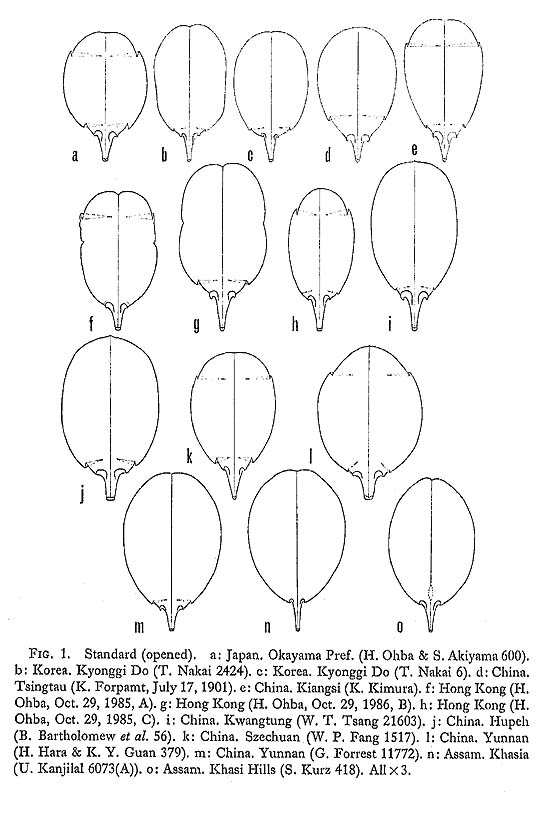
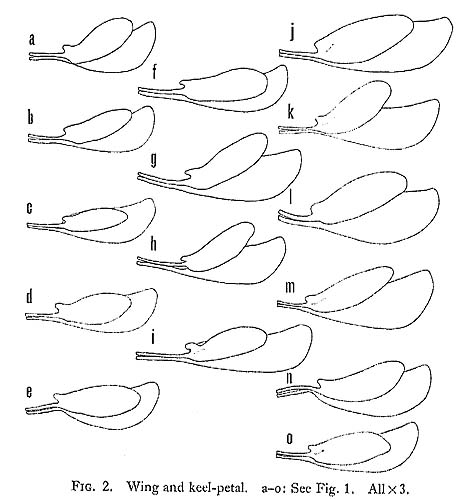
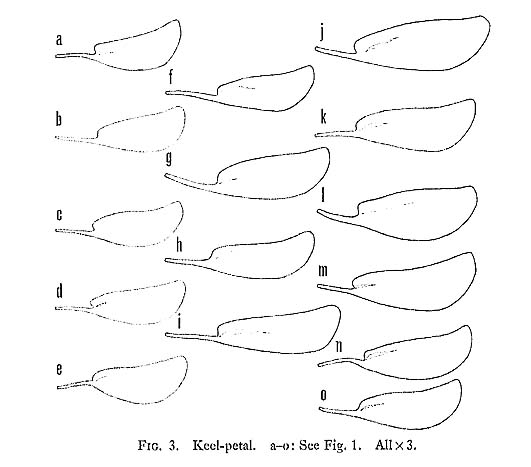
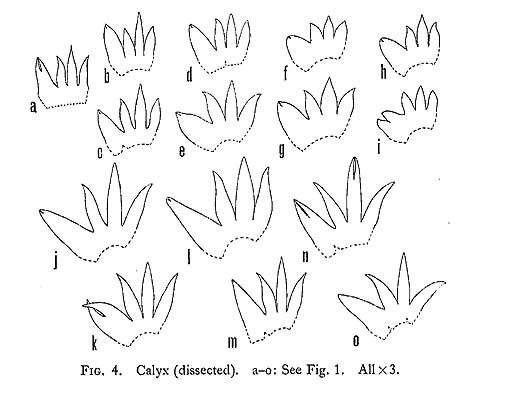
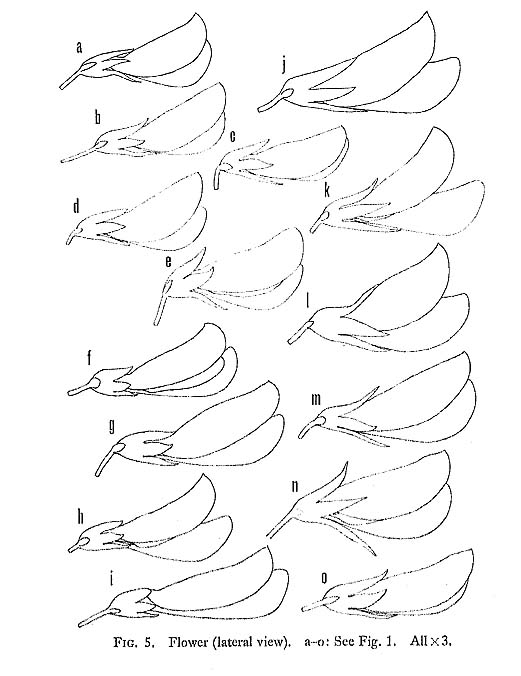
 ,
,  )). It is remarkable that the type specimen of L.formosa has rather exceptional flowers (Fig. 6, 1).
)). It is remarkable that the type specimen of L.formosa has rather exceptional flowers (Fig. 6, 1).
 )); and the relative length of corolla/calyx is two to three times shorter than that of Hong Kong, Kwangtung, Fukien and Taiwan.
)); and the relative length of corolla/calyx is two to three times shorter than that of Hong Kong, Kwangtung, Fukien and Taiwan. , Ο)). Their flowers apparently fall in the same variation range as those of Japan (Figs. 5a & 6a, b, c) and Korea (Figs. 5b, c & 6 (
, Ο)). Their flowers apparently fall in the same variation range as those of Japan (Figs. 5a & 6a, b, c) and Korea (Figs. 5b, c & 6 (

